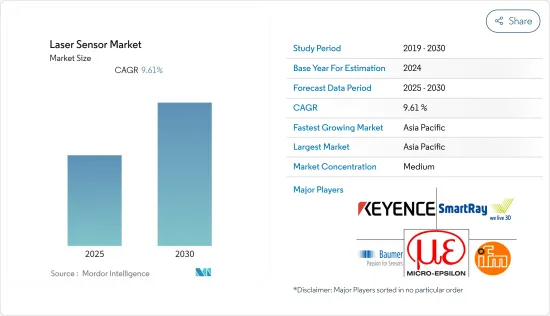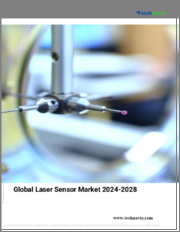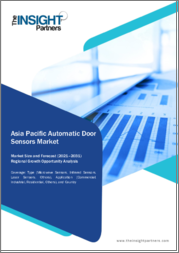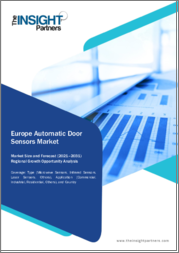
|
시장보고서
상품코드
1683399
레이저 센서 : 시장 점유율 분석, 산업 동향 및 통계, 성장 예측(2025-2030년)Laser Sensor - Market Share Analysis, Industry Trends & Statistics, Growth Forecasts (2025 - 2030) |
||||||
레이저 센서 시장은 예측 기간 동안 CAGR 9.61%를 나타낼 것으로 예상됩니다.

주요 하이라이트
- 레이저 거리 센서는 비접촉식 거리 측정용으로 설계되었습니다. 레이저 게이지는 최대 10m, 레이저 거리 센서는 최대 3,000m까지 측정할 수 있습니다. 이러한 센서는 일반적으로 기계 제조 및 핸들링 장비의 위치 결정 및 유형 분류에 사용됩니다.
- 2020년 2월, 인더스트리 4.0을 위한 진동 센서를 제조 및 공급하는 VocalZoom(VZ)은 IIoT용 자율형 레이저 센서를 출시한다고 발표했습니다. 이 제품은 비접촉식 고해상도 진동 센서 기술과 내장형 데이터 처리 및 무선 통신을 결합하여 IIoT 환경을 위한 광범위한 위치 확인 및 모니터링 용도를 저렴한 비용으로 신속하게 구축할 수 있습니다.
- 또한, 안정적이고 정확한 측정을 실현하는 것은 신뢰할 수 있는 제품 가치와 오류 없는 생산을 보장하기 위해 필수적입니다. 레이저 센서는 반사 표면, 다양한 소재 및 색상에 사용할 수 있습니다. 이 센서는 견고하고 독립적인 하우징, 선형 이미저, 핀 포인트 레이저 이미터로 구성되어 있습니다.
- 에머슨에 따르면, 세계 공장 자동화 시장의 성장 전망은 2019년 3%에서 2021년 3.5%로 증가할 것으로 예상되며, 이는 시장 수요를 크게 뒷받침하고 있습니다. 또한, 해양 및 해양 산업에서 레이저 센서 기술 혁신의 활용이 향후 트렌드가 될 것으로 예상됩니다. 주로 레이저 기반 항법 보조 장치인 LADAR(Laser Detection and Ranging)는 장거리 물체 감지와 고정밀 측정을 결합하여 사용자에게 최적의 해상 인식을 위한 완벽한 2D/3D/4D(3D+시간) 관점을 제공합니다.
- 또한 기업은 새로운 장치와 기술 혁신을 혁신하고 레이저 센서의 통합을 제공하고 있으며, 이는 시장 성장의 요인이 되고 있습니다. 예를 들어, 2020년 4월 샤오미는 인도에서 새로운 스마트 IoT 가전제품인 Mi Vacuum-Mop P 시리즈를 출시했는데, Mi Vacuum은 12개의 다방향 센서와 전용 레이저 거리 센서(LDS) 내비게이션 시스템을 탑재하여 복잡한 환경을 정확하게 스캔하고 청소 중 장애물을 피할 수 있습니다. 복잡한 환경을 정확하게 스캔하고 청소 중 장애물을 피할 수 있습니다.
- 중국에서 발생한 코로나19는 세계 최대의 하이테크 제조 기지에서의 사업을 위협하고 있어 세계 하이테크 부문, 특히 하드웨어, 전자 제조 서비스 제공업체, 반도체 기업들을 혼란에 빠뜨리고 있습니다. 또한, 코로나19 사태에 대비하기 위해 연구자들은 타액이나 콧물에서 몇 분 만에 질병을 감지할 수 있는 레이저 센서를 개발하고 있습니다. 이 비침습적 광학 바이오센서 시연기는 코로나19가 체내에 존재하는 즉시 이를 감지할 수 있다고 합니다. 연구진은 이미 다른 용도로 사용할 수 있는 6대의 실용적인 실험용 데모 기기를 만들었으며, 이 기술은 아직 더 많은 개발과 테스트가 필요하지만, 2020년 안에 출시될 수 있을 것이라고 밝혔습니다. 이는 이 분야 시장 성장에 크게 기여할 것입니다.
레이저 센서 시장 동향
자동차가 큰 성장을 이룰 것으로 예상
- 자동차와 같은 최종 사용자 산업은 레이저 활용의 발전으로 큰 혜택을 받고 있으며, 그 중 많은 부분이 자율 주행 자동차의 미래 판임베디드니다. 자율 주행 자동차는 다른 센서, 특히 레이더와 카메라를 사용하여 시야를 확보하지만, 레이저 시야는 이에 필적하기 어렵습니다. 레이더는 신뢰할 수 있지만 팔이나 다리와 같은 것을 찾는 데 필요한 해상도를 제공하지 않습니다. 카메라는 상세한 정보를 제공하지만, 2차원 이미지를 3차원 이해로 변환할 수 있는 머신러닝 기능을 갖춘 소프트웨어를 채택해야 합니다. 반면, 라이더는 정확한 측정값의 형태로 컴퓨터가 사용하기 쉬운 데이터를 제공합니다.
- 2020년 6월, 마우저는 오스람 옵토세미컨덕터(Osram Opto Semiconductors)의 라이더 비전 SPL S 1 L90 A 및 SPL S 4 L90 A 레이저를 강화했습니다. 이 고출력 적외선 SMT 부품은 자율 주행 차량 및 기타 LiDAR 용도에 사용하기에 적합한 905nm의 레이저 파장을 특징으로 합니다. 이 레이저는 채널당 40A에서 120W의 표준 출력을 채널당 최대 33%의 효율로 제공합니다. 이 레이저는 열 저항이 낮기 때문에 고전류로 작동할 때에도 부품에서 열을 빠르게 방출할 수 있습니다.
- 또한 현재 Livox Technology는 Livox Tele-15 차량용 라이더를 대량 생산할 수 있는 규모로 세계 시장에 출시하고 있으며, Livox Tele-15는 고도의 장거리 감지를 위해 설계되었으며, 컴팩트한 형태로 내구성이 뛰어나고 고정밀 시스템을 제공합니다. 현재 반사율이 낮은 물체의 감지 범위는 반사율 10%에서 200m에서 320m까지 60% 확대되었으며, 반사율 50%에서 500m까지 감지할 수 있습니다.
- 이와는 별도로 각국 정부도 전 세계적으로 ADAS 기능의 도입을 장려하고 있으며, 이는 시장 성장을 가속할 것입니다. 예를 들어, 미국 교통부 도로교통안전국(NHTSA)은 첨단운전자보조시스템(ADAS) 기능 탑재 차량부터 자율주행차까지 고도 자율주행차(HAV)와 관련된 연방 자율주행차 정책을 발표했습니다.
- 또한 2020년 6월, 인포워크는 현대자동차와 공동으로 자율주행차용 센서인 주파수 변조 연속파(FMCW) 기술 개발을 시작한다고 발표했습니다. 개발 중인 FMCW LiDAR는 레이저로 물체의 거리를 측정하고 그 주변을 정밀한 3D 이미지로 모델링하는 센서입니다.
북미가 큰 성장을 이룰 것으로 예상
- 북미는 레이저 센서의 제조, 설계 및 연구 분야에서 신기술을 가장 먼저 채택하는 것으로 알려져 있습니다. 이 지역의 우수성은 전자기기 수출 수요와 방위, 가전 등 레이저 센서의 중요한 수요처인 최종 사용자 산업의 성장을 견인하고 있습니다.
- 군사 및 국방 분야에서 미 국방부는 200 미터 떨어진 곳에서 사람의 심장 특징을 식별 할 수있는 적외선 레이저를 개발했으며, Jetson으로 알려진이 레이저 프로토타입은 멀리 떨어진 곳에서 심장 박동으로 인한 표면 진동을 측정하는 데 사용됩니다. 적절한 조건에서 이 기술은 95%의 확률로 식별할 수 있습니다.
- 또한 미국 국방부는 미국 특수 작전 부대의 요청에 따라 이 원리를 이용하여 주로 적군 전투원의 심장 신호를 읽어 먼 거리에서 적군 전투원을 식별할 수 있는 적외선 레이저를 개발했습니다. 이 레이저는 의복을 관통하여 최대 200미터 떨어진 곳에서 약 95%의 확률로 식별을 달성할 수 있을 것으로 예상됩니다.
- 또한 2019년 10월 미국 육군협회 연례총회에서 방산 대기업 L3Harris Technologies는 육군의 최신 드론인 Shadow에 탑재될 65대의 전기광학 센서 제품군을 수주했다고 발표했습니다. 이 드론은 전술 무인항공 시스템인 Shadow UAV(RQ-7Bv2)에 탑재되도록 구성되어 있으며, 이번 계약은 65대의 WESCAM MX-10D 전기광학, 적외선, 레이저 디지게이터 센서 제품군입니다.
- 또한, 가전제품 분야에서는 스마트폰, 태블릿, AI 지원 전자기기가 높은 성장세를 보이고 있습니다. 이는 미국 레이저 센서 시장의 성장에 영향을 미칠 것으로 예상됩니다. 미국 소비자 기술 협회(CTA)가 실시한 미국 소비자 기술 판매 및 예측 조사에 따르면, 스마트폰이 창출하는 수익은 2018년 791억 달러, 2019년 775억 달러로 평가되고 있습니다.
레이저 센서 산업 개요
레이저 센서 시장은 여러 업체가 존재하기 때문에 경쟁이 치열합니다. 시장은 적당히 집중되어 있는 것으로 보입니다. 여러 비 레이저 제조업체가 시장에 진입하여 기회를 활용하거나 자체 용도에 센서를 사용하고 있습니다. 또한 많은 레이저 제조업체들이 제품 포트폴리오를 확장하기 위해 인수를 진행하고 있습니다. 최근 동향은 다음과 같습니다.
- 2020년 4월 - SmartRay는 소비자 전자제품 제조의 다양한 용도 요건을 충족하는 균형 잡힌 ECCO 센서 제품군에 또 하나의 제품을 추가하여 SmartRay의 청색 레이저 기술을 활용하여 낮은 시야각에서도 이미지 품질과 재현성을 구현합니다. ECCO 95.020은 초당 최대 2,000만 점의 3D 스캔을 제공합니다.
- 2019년 11월 - 마이크로이피션트는 고속 변위, 거리 및 위치 측정을 위한 새로운 블루 레이저 버전을 도입하여 레이저 삼각측량 센서로 구성된 optoNCDT 1750 포트폴리오를 확장했습니다. 이 센서에는 새로운 고성능 렌즈, 레이저 제어 및 평가 알고리즘이 탑재되어 다양한 표면과 재료에 대한 정확한 측정이 가능합니다.
기타 특전:
- 엑셀 형식 시장 예측(ME) 시트
- 3개월간 애널리스트 지원
목차
제1장 서론
- 조사 상정과 시장 정의
- 조사 범위
제2장 조사 방법
제3장 주요 요약
제4장 시장 역학
- 시장 개요
- 시장 성장 촉진요인
- 시장 성장 억제요인
- 밸류체인 분석
- 업계의 매력 - Porter의 Five Forces 분석
- 신규 진출업체의 위협
- 바이어의 교섭력
- 공급 기업의 교섭력
- 대체품의 위협
- 경쟁 기업간 경쟁 관계
- COVID-19의 업계에 대한 영향
제5장 시장 세분화
- 컴포넌트별
- 하드웨어와 소프트웨어
- 서비스
- 최종사용자 산업별
- 일렉트로닉스 제조
- 항공 산업
- 건설
- 자동차 산업
- 기타 최종사용자 산업
- 지역별
- 북미
- 미국
- 캐나다
- 유럽
- 영국
- 독일
- 프랑스
- 기타 유럽
- 아시아태평양
- 중국
- 일본
- 인도
- 한국
- 기타 아시아태평양
- 세계 기타 지역
- 북미
제6장 경쟁 구도
- 기업 개요
- Keyence Corporation
- Micro-Epsilon Messtechnik GmbH & Co. KG
- IFM Electronic GmbH
- Baumer Electric AG
- SmartRay GmbH
- MTI Instruments Inc.
- Rockwell Automation Inc.
- Dimetix AG
- First Sensor AG
제7장 투자 분석
제8장 시장 기회와 향후 동향
LSH 25.03.28The Laser Sensor Market is expected to register a CAGR of 9.61% during the forecast period.

Key Highlights
- Laser distance sensors are designed for non-contact distance measurements: laser gauges for measuring ranges up to 10 meters, laser distance sensors for up to 3,000m. These sensors are generally utilized for positioning and type classification in machine building and handling equipment.
- Moreover, in Feb 2020, VocalZoom (VZ), a manufacturer and provider of vibration sensors for industry 4.0, announced the launch of its autonomous laser sensors for the IIoT. It combines contactless, high-resolution vibration sensor technology with built-in data processing and wireless communications. It offers low-cost and fast deployment of a wide range of positioning and monitoring applications for IIoT environments.
- Further, attaining stable and accurate measurements is essential to ensure reliable product values and error-free production. The laser sensor can be used on reflective surfaces, numerous materials, and colors. These sensors are incorporated with rough, independent housing, a linear imager, a pinpoint laser emitter.
- According to Emerson, the projected growth of the global factory automation market is expected to increase from 3% in 2019 to 3.5% by 2021, which significantly holds the market demand. Further, the use of laser sensor technology innovation in the maritime and offshore industry is expected to be a future trend. Primarily a laser-based navigational aid, LADAR (Laser Detection and Ranging), combines long-distance object detection with high -accuracy measurement, giving users a full 2D/ 3D/4 D ( 3 D plus time) perspective for optimal maritime awareness.
- Further, players are innovating new devices and technology innovation, providing the integration of laser sensors, which are attributing to market growth. For instance, in April 2020, Xiaomi unveiled the company's new smart Internet of Things (IoT) home appliance Mi Vacuum -Mop P series in India. The Mi Vacuum is incorporated into twelve different multi-directional sensors and a dedicated Laser Distance Sensor (LDS) navigation system such that it can be used to scan complex environments accurately and avoid obstacles during the cleaning process.
- The COVID -19 outbreak in China is disrupting the global tech sector, especially hardware, electronic manufacturing services providers, and semiconductor companies, as operations in the world's largest tech manufacturing hub are threatened. Also, for the COVID -19 situation, researchers have been developing a laser sensor that can pick up diseases at the earliest point of infection from saliva or nasal swab in minutes. They say the non -invasive optical biosensor demonstrator will pick up COVID-19 in people as soon as it is present in the body. The researchers already created six working laboratory demonstrators for other applications and said that the technology still needs further development and testing but could be available within 2020. This significantly helps the market growth in this sector.
Laser Sensor Market Trends
Automotive is Expected to Witness Significant Growth
- End-user industries such as automotive, are greatly benefiting from the advances in laser use, mostly with future sales of the autonomous vehicle. Autonomous cars use other sensors to see, notably radars and cameras, but laser vision is hard to match. Radars are reliable but do not offer the resolution needed to pick out things like arms and legs. Cameras deliver the detail but it requires adopting machine-learning-powered software such that it that can translate 2-D images into 3-D understanding. Lidar on the other hand offers hard, computer-friendly data in the form of exact measurements.
- In June 2020, Mouser has enhanced the lidar vision SPL S 1 L90 A and SPL S 4 L90 A lasers from Osram Opto Semiconductors. The high -power, infrared SMT components feature a 905 nm laser wavelength suitable for use in autonomous vehicles and other LiDAR applications. The lasers provide a typical output of 120 W at 40 A per channel, at up to 33 % efficiency. The lasers feature low thermal resistance, enabling heat to dissipate quickly from components even when operating at high currents.
- Further, currently, Livox Technology is bringing its Livox Tele -15 automotive lidar to the global market on a mass-producible scale. It is designed for advanced long-distance detection, where the Livox Tele -15 offers a durable, high precision system in a compact form. Now, objects with low reflectivity have an increased detection range of 60 % from 200 meters to 320 meters at 10 % reflectivity, and it will also detect objects at 500 m with 50 % reflectivity, previously requiring 80 % reflectivity at that distance.
- Apart from this, governments across the globe are also encouraging the deployment of ADAS features worldwide, which will drive the growth of the market. For instance, the US Department of Transportation's National Highway Traffic Safety Administration (NHTSA) published the Federal Automated Vehicles Policy related to highly-automated vehicles (HAV), which range from vehicles with advanced driver-assistance systems features to autonomous vehicles.
- Additionally, in June 2020, Infowork announced that it would start developing the Frequency Modulated Continuous Wave (FMCW) technology, a sensor for self -driving vehicles, in collaboration with Hyundai Motors. The FMCW LiDAR under development is a sensor that measures the distance of an object with a laser and models its surroundings with precise 3D images.
North America is Expected to Witness Significant Growth
- The North American region is known to be the early adopters of new technology in manufacturing, design, and research in the laser sensor. The region's prominence drives the demand in exporting electronics equipment and growing end-user industries that are significant consumers of laser sensors such as defense, consumer electronics, etc.
- In military and protection, the Pentagon developed an infrared laser that can identify a person's unique cardiac signature up to 200 meters away. The laser prototype which is known as Jetson is used in the measurement of surface vibrations caused by the heartbeat at a distance. Under suitable conditions, the technology can achieve an identification 95 percent of the time.
- Moreover, the Department of Defense, at the request of United States special operations forces, used the principle, primarily to develop an infrared laser that can be used in the identification of enemy combatants from a significant distance by reading their cardiac signature. The laser is expected to penetrate clothing and achieve an identification roughly 95% of the time from up to 200 meters away.
- Further, in Oct 2019, the during the association of the United States Army's annual meeting, the defense giant L3Harris Technologies announced that the company got an order from the Army for 65 electro-optical sensor suite units, to mount on the service's latest Shadow drones. The drones are configured to fit on the Tactical Unmanned Air Systems Shadow UAV (RQ-7Bv2), the contract is for 65 WESCAM MX-10D electro-optical, infrared and laser designator sensor suites.
- Moreover, in the consumer electronic segment, smartphones, tablets, and AI-assisted electronics are experiencing high growth. This is expected to influence the growth of the laser sensor market in the country. According to the US Consumer Technology Sales and Forecast study, which was conducted by the Consumer Technology Association (CTA), the revenue generated by smartphones was valued at USD 79.1 billion and USD 77.5 billion in 2018 and 2019.
Laser Sensor Industry Overview
The Laser Sensor market is highly competitive owing to the presence of multiple vendors. The market appears to be moderately concentrated. Multiple non-laser companies are entering the market to leverage the opportunities its presents or use the sensors for their applications. Additionally, many laser manufacturers are making acquisitions to expand their product portfolio. Some of the recent developments in the industry are as follows: -
- April 2020 - SmartRay launched one more product in its ECCO sensor family which is balanced for the diverse application requirements of consumer electronics manufacturing. Utilizing SmartRay's blue laser technology for image quality and repeatability, even for applications with low field-of-view, ECCO 95.020 offers 3D scanning of up to 20 million points per second.
- November 2019 - Micro-Epsilon has extended its optoNCDT 1750 portfolio which comprises laser triangulation sensors with the introduction of a new Blue Laser version for measuring fast-displacement, distance, and position. The sensors have new high-performance lenses, laser control, and evaluation algorithms to facilitate precise measurements on different surfaces and materials.
Additional Benefits:
- The market estimate (ME) sheet in Excel format
- 3 months of analyst support
TABLE OF CONTENTS
1 INTRODUCTION
- 1.1 Study Assumption and Market Definition
- 1.2 Scope of the Study
2 RESEARCH METHODOLOGY
3 EXECUTIVE SUMMARY
4 MARKET DYNAMICS
- 4.1 Market Overview
- 4.2 Market Drivers
- 4.2.1 Increasing Adoption of Industry 4.0 and Smart Manufacturing Practices
- 4.2.2 Reduction of Price Leading to Large Scale Application
- 4.3 Market Restraints
- 4.3.1 High Requirement of Power and Energy Density for Measuring Smaller Beams
- 4.4 Industry Value Chain Analysis
- 4.5 Industry Attractiveness - Porter's Five Force Analysis
- 4.5.1 Threat of New Entrants
- 4.5.2 Bargaining Power of Buyers
- 4.5.3 Bargaining Power of Suppliers
- 4.5.4 Threat of Substitute Products
- 4.5.5 Intensity of Competitive Rivalry
- 4.6 Impact of COVID-19 on the Industry
5 MARKET SEGMENTATION
- 5.1 Component
- 5.1.1 Hardware and Software
- 5.1.2 Services
- 5.2 End-user Industry
- 5.2.1 Electronics Manufacturing
- 5.2.2 Aviation
- 5.2.3 Construction
- 5.2.4 Automotive
- 5.2.5 Other End-user Industries
- 5.3 Geography
- 5.3.1 North America
- 5.3.1.1 United States
- 5.3.1.2 Canada
- 5.3.2 Europe
- 5.3.2.1 United Kingdom
- 5.3.2.2 Germany
- 5.3.2.3 France
- 5.3.2.4 Rest of Europe
- 5.3.3 Asia-Pacific
- 5.3.3.1 China
- 5.3.3.2 Japan
- 5.3.3.3 India
- 5.3.3.4 South Korea
- 5.3.3.5 Rest of Asia-Pacific
- 5.3.4 Rest of the World
- 5.3.1 North America
6 COMPETITIVE LANDSCAPE
- 6.1 Company Profiles
- 6.1.1 Keyence Corporation
- 6.1.2 Micro-Epsilon Messtechnik GmbH & Co. KG
- 6.1.3 IFM Electronic GmbH
- 6.1.4 Baumer Electric AG
- 6.1.5 SmartRay GmbH
- 6.1.6 MTI Instruments Inc.
- 6.1.7 Rockwell Automation Inc.
- 6.1.8 Dimetix AG
- 6.1.9 First Sensor AG



















